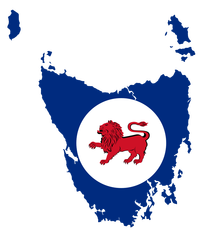
Tasmania
Last updated: Wednesday September 15th, 2021
Report this blog
Geographical Information
Tasmania is the southernmost state in Australia, located about 240km south of mainland Australia. It is an island of around 550,000 people. Tasmania has an area of 68,401km2 with the main island (also called Tasmania) being the 26th largest island in the world (27th if the Australian mainland is an island). Tasmania's capital and biggest city is Hobart in the states south, with a population of about 220,000 people, making it the 11th most populated city in Australia.
Tasmania's other major towns and cities include Launceston (120,000), Devonport (30,000), Burnie (25,000), Kingston (20,000), and Ulverstone (15,000).
Tasmania is bordered by the Bass Strait to the North, the Tasman Sea to the East, the Southern Ocean to the South, and the Indian Ocean to the West.
Tasmania is made up of over 6,500 islands (most of which are very small). The most notable islands are the Tasmanian mainland, King Island, Flinders Island, Bruny Island, Maria Island, Cape Barren Island, and Macquarie Island.
King Island is Tasmania's most populous island (besides the mainland), with about 2,000 people. The island is famous for its cheese industry, and its popular surfing destinations. The most populated town on King Island is Currie, with about 1,000 people.
Flinders Island is Tasmania's largest island (besides the mainland) and has about 1,000 people. It is famous for its pristine beaches and forests, and its biggest town, Whitemark, has about 150 people.
Bruny Island is famous for its cheese and wildlife (namely seals and dolphins) and its remarkable coastline.
Maria Island is popular for bushwalkers and is the location of a Tasmanian Devil rehabilitation project.
Cape Barren Island is just south of Flinders Island and is home to only 66 people.
Macquarie Island is the closest point in Australia to Antarctica (besides the AAT itself) and is home to researchers, elephant seals, penguins, and orcas (killer whales).
Tasmania is divided into 26 different municipalities/council areas/LGA's. These are:
- Break O'Day (pop. 6,000) - Major settlements: St Helens, Scammander
- Brighton (18,000) - Brighton
- Burnie (20,000) - Burnie, Ridgley
- Central Coast (22,000) - Ulverstone, Penguin
- Central Highlands (2,000) - Hamilton
- Circular Head (8,000) - Smithton, Stanley
- Clarence (59,000) - Clarence (Hobart), Richmond
- Derwent Valley (11,000) - New Norfolk
- Devonport (26,000) - Devonport
- Dorset (7,000) - Scottsdale, Bridport
- Flinders (1,000) - Whitemark, Lady Baron
- George Town (7,000) - George Town
- Glamorgan-Spring Bay (5,000) - Bicheno, Swansea, Orford-Triabunna
- Glenorchy (48,000) - Glenorchy (Hobart), Moonah (Hobart)
- Hobart (55,000) - Hobart
- Huon Valley (18,000) - Huonville
- Kentish (6,000) - Sheffield, Railton
- Kingborough (39,000) - Kingston-Blackmans Bay
- King Island (2,000) - Currie, Grassy
- Latrobe (12,000) - Latrobe, Port Sorell
- Launceston (69,000) - Launceston, Perth, Longford
- Meander Valley (20,000) - Deloraine, Westbury
- Northern Midlands (14,000) - Campbell Town, Ross
- Sorell (16,000) - Sorell-Midway Point
- Southern Midlands (6,000) - Oatlands
- Tasman (2,000) - Port Arthur
- Waratah-Wynyard (14,000) - Wynyard, Somerset (Burnie), Waratah
- West Coast (4,000) - Queenstown, Strahan
- West Tamar (24,000) - Legana, Beaconsfield
Tasmania is Australia's coldest state with temperatures ranging from up to 30 degrees Celsius in the Summer (Dec-Feb), to 15 degrees Celsius (and sometimes much colder) in the Winter (Jun-Aug). Rainfall ranges from 80mm in August to 25mm in February.
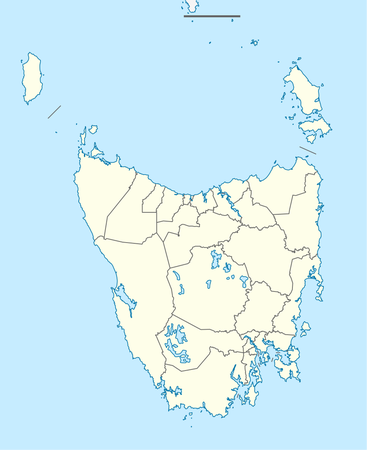

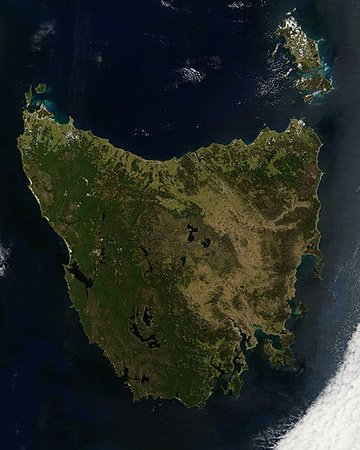
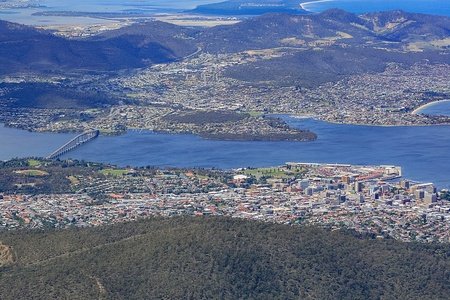
Animals (Wildlife)
Tasmania is widely covered in "bush" or forest/woods. The bush is home to extremely diverse wildlife, some of which is only existent in Tasmania. Tasmania is most famous for these animals:
- Tasmanian Devil
- Platypus
- Echidna
- Wallaby
- Possum
- Kangaroo (Eastern Grey)
- Quoll
- Kookaburra
- Fairy Penguin
- Dolphin (Bottlenose, Orca etc.)
- Tiger Snake
- Wombat
- Tasmanian Tiger/Thylacine (Extinct)
- Whales (Humpback, Pilot, Southern Right etc.)
The Tasmanian Devil is the most famous animal associated with Tasmania. As its name suggests, it is found only in Tasmania, although research suggests that the Devil was formerly existent on the mainland and in New Guinea. Despite its fearsome reputation, the Tasmanian Devil is a shy animal and mostly nocturnal. It receives the name "Devil" from its bloodcurdling call that can be heard in the night. They often scavenge for roadkill, but are also talented hunters. A single Devil can roam over 50km in search of food in a single night. They are about the size of a small dog, and are closely related to the quoll. They are also famous for having the strongest bite of any animal for their size and are the largest carnivorous marsupial in the world. Over the last few decades a deadly facial tumour has threatened the species and now they are a highly endangered species. There are many projects focused on saving the species from extinction.
Many of Tasmania's wildlife the coexist on the mainland (wombats, wallabies, platypuses for example) are much larger in Tasmania. This is because of the colder climate, and the fact that they have no major predator (besides quolls and devils).
Tasmania is home to 3 species of snakes, all of which are venomous. The most common and most deadly is the Tiger Snake, defined by its distinctively yellow underbelly. The tiger snake is in the top ten deadliest snakes on the planet, but are not dangerous unless threatened.
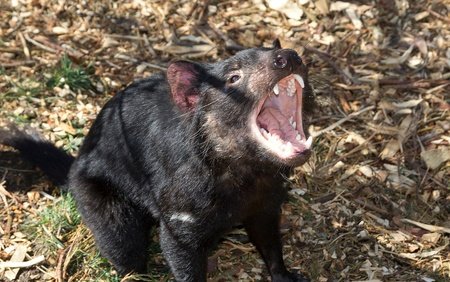
Tourism
Tasmania is a tourist hotspot and is the hidden gem of Australia. Although it is often overlooked by tourists to Australia, it it absolutely worth the trip down. To get to Tasmania there are 2 methods - flight or sailing. There are airports in Burnie (Wynyard), Devonport, Launceston, and Hobart, with flights coming from major cities like Sydney, Melbourne, Brisbane, Adelaide, and even Auckland (NZ). The biggest airport is in Hobart, and it is the only international airport in Tasmania.
The Spirit of Tasmania is a large ferry that travels between Melbourne (soon to be Geelong) and Devonport. This is used mostly by passengers who have a vehicle that they can have transported between the mainland and Tasmania.
Tasmania can be split into 5 different areas for tourism. These are:
- North-West
- West Coast
- North
- East Coast
- South
The North-West is the forgotten gem of Tasmania. It has untouched wilderness areas, pristine, beautiful beaches, the best bushwalks and the cleanest air in the world. The Cradle Mountain World Heritage Area is one of only two UNESCO areas in the world to meet 7 criteria (the highest on the planet). Major tourist destinations include:
- Gunns Plains Caves
- Wings Wildlife Park
- Leven Canyon
- Cradle Mountain World Heritage area
- The Overland Track
- Guide Falls
- Boat Harbour Beach
- Table Cape tulips
- Stanley and the Nut
- Tarkine Wilderness area
- Sheffield (town of murals)
- Tasmazia and the town of Lower Crackpot
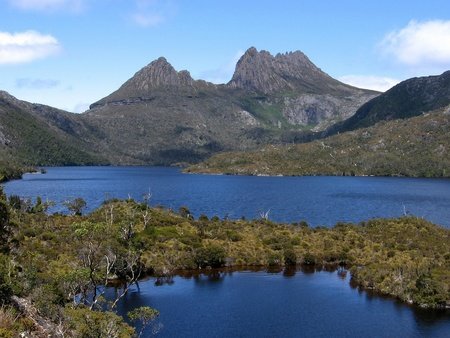
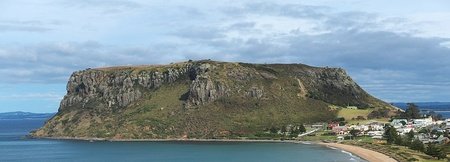

The West Coast is the wettest and wildest part of Tasmania with rainforest galore and a huge mining and fishing industry. Major attractions include:
- Montezuma Falls
- Macquarie Harbour
- Gordon River World Heritage Area
- West Coast Wilderness Railway
- Lake St Clair
- Gordon Dam
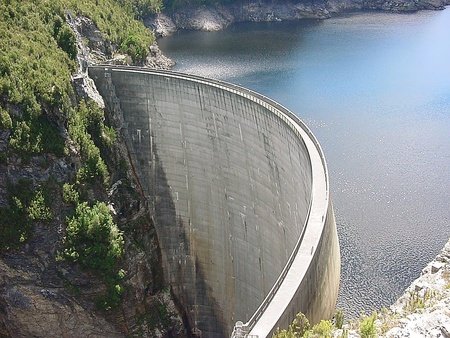
The North is the bustling centre of culture and cuisine, with foodie trails and festivals. Major tourist attractions are:
- The Cataract Gorge (Launceston)
- The Tamar Valley
- Waterhouse
- Launceston
- Deloraine
- Tasmania Zoo
- Hollybank Treetop Adventures
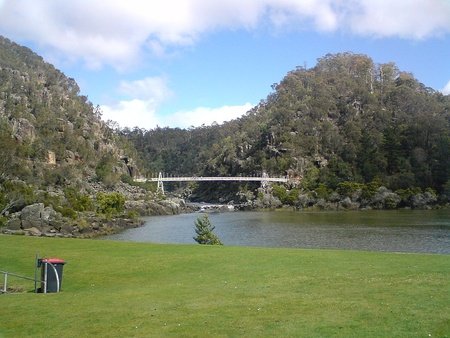
The East Coast is the driest place in Tasmania is is famous for its rugged coastline, including some of the top 10 beaches in the world.
- Wineglass Bay (Freycinet National Park)
- Bay of Fires
- Maria Island
- Bicheno
- Derby & St Helens MTB Trails
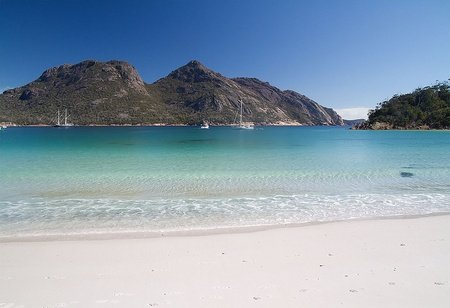
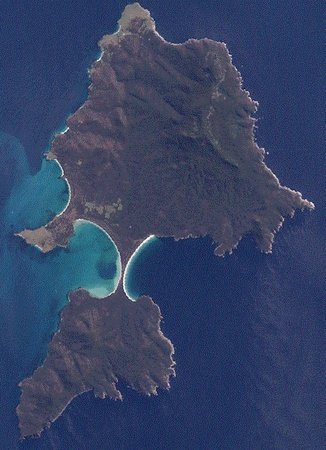

The South is home to Hobart, the centre of Tasmania's many industries and for many, the starting place in their Tassie journey. Attractions in the south include:
- Hobart (especially Salamanca Markets and Mt Wellington)
- Richmond
- Huon Valley
- Derwent Valley
- Tasman Peninsula
- Port Arthur Penal Colony and Prison Ruins
- Cadbury Chocolate Factory
- Bruny Island
- Southwest Wilderness Area
- Mt Field National Park



History
Tasmania has a rich and diverse history that extends back thousands of years. The first known settlers of Tasmania were the Tasmanian Aboriginal people. They are thought to have come from mainland Australia and arrived in Tasmania before the Bass Strait was there and Tasmania was still connected to the mainland. When the sea level rose after the ice age, Tasmania was separated from the mainland and became the island it is today. The Tasmanian Aboriginals continued to live in Tasmania for thousands of years. The Aboriginals called Tasmania 'Trowunna' or 'Loetrouwitter'.
In 1642, Dutch explorer Abel Tasman, became the first European to sight Tasmania. Tasman named the island Van Diemen's Land after his superior, Anthony Van Diemen (governor of the Dutch East Indies or now Indonesia). In September 1804, British naval officer and superintendent, Lieutenant John Bowen became the first European to settle in Tasmania at Risdon Cove (Hobart). Hobart then became Australia's second oldest settlement (behind Sydney).
Tasmania became a place where the British sent their convicts, with penal colonies being founded in Port Arthur, Maria Island, and Sarah Island (Macquarie Harbour).
Van Diemen's Land began to grow in population with the rest of Australia and it was renamed Tasmania (after Abel Tasman) in 1856. At one stage, the now small mining town of Zeehan in the West Coast was the third largest settlement in Tasmania because of the dozen mines around. At its height, Zeehan had around 10,000 people, much more than its current population of around 700 people.
The city of Burnie was a large city as well, with a large papermaking industry. It also has the deepest port in the southern hemisphere, making it an important port on the trade route for Tasmania.
Other Facts
- Over 20% of Tasmania is covered in the Tasmanian Wilderness World Heritage Area (the second-highest rated in the world by UNESCO).
- Hobart is the second driest capital in Australia.
- Tasmania has the oldest trees in the world.
- Tasmania has the cleanest air in the world.
- A bushwalkers paradise, Tasmania has over 2,000km of walking trails, and 18 national parks.
- The Danish Princess, Mary Donaldson, was born and raised in Hobart.
- Tasmania has 69 golf courses (along with the oldest in the southern hemisphere).
- World-famous cricket batsman Ricky Ponting was born and raised in Launceston and is a proud Tasmanian.
- Tasmania produces the only bottled rainwater in the world that is approved by world health departments.
- Netherlands import tulips from Tasmania but get the fame as well.
- If Tasmania was its own country it would be the 21st richest country in the world per capita!
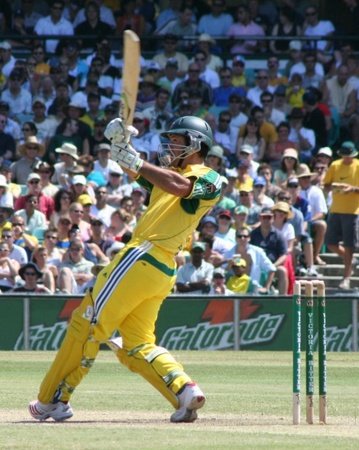
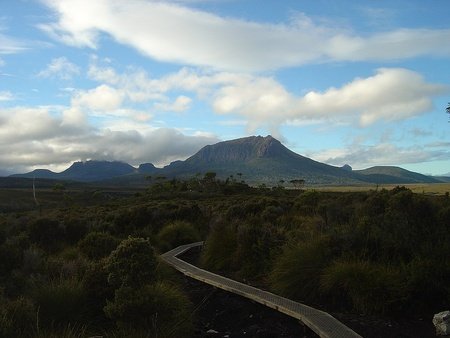
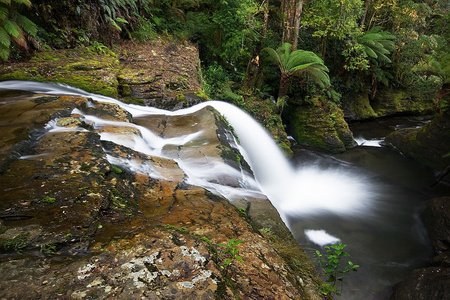
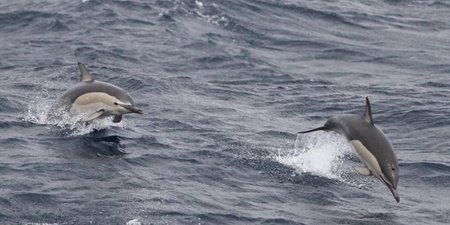
Anyway, thanks for reading, and I hope you enjoyed my first blog! If there is anything I missed, anything that needs improvement, or anything else you would like to know, please leave a comment.

I think I should start my Minas Gerais one...Very good!